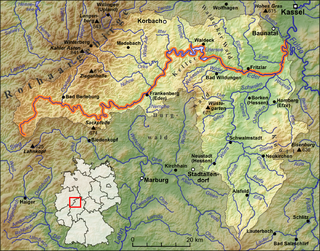Eder
| Eder | |
|---|---|

The Eder in Edersee when the lake dried out in 2003
|
|

Map of the Eder, its tributaries and water catchment area
|
|
| Native name | Eder |
| Other name(s) | Edder |
| Etymology | Adrana-Aderna-Adarna-Adrina-Edder-Eder |
| Country | Germany |
| States | North Rhine-Westphalia-Hesse |
| Basin features | |
| Main source | Ederkopf 634 m (2,080 ft) |
| River mouth | Edermünde 142 m (466 ft) |
| Progression | Fulda→ Weser→ North Sea |
| River system | Weser |
| Basin size | 3,362 km2 (1,298 sq mi) |
| Tributaries |
|
| Physical characteristics | |
| Length | 177 km (110 mi) |
| Discharge |
|
The Eder is a 177-kilometre (110 mi) long major river in Germany that begins in eastern North Rhine-Westphalia and passes in to Hesse, where it confluences with the River Fulda.
The river was first mentioned by the Roman historian Tacitus. In his Annals, he describes the Roman campaign against the Chatti under the command of Germanicus in 15 AD. Forty-five thousand soldiers of the Roman army destroyed the major centre of the Chatti, Mattium, directly after they crossed the Adrana (Eder).
In the Middle Ages, the river was known by the names; Aderna, Adarna, Adrina.
On the banks of the Eder, in the town of Schwarzenau, near Bad Berleburg, a religious group was founded in August 1708; the Schwarzenau Brethren. Eight adults were completely baptised thrice in the Eder. This group emigrated to America where they are still to be found.
As late as up to the end of the 19th Century, the river was also known in local dialect as Edder. For instance, in Felsberg-Gensungen, the pharmacy is known as the Edder-Apotheke.
Sediments of the Eder contain a proportion of gold. The majority of this gold is said to originate from Eisenberg (Korbach), which contains one of the largest reserves of gold in Middle Europe. Gold is eroded out of the Eisenberg, for example, by the Itter stream, which, since the Edersee dam was built, flows into the Edersee lake.
Gold panning in the Eder has been known since 1308. The main historical area for panning the gold is between Affoldern and Fritzlar. In the 14th Century, the Teutonic Order panned gold out of the Eder sediments near Obermöllrich. In the 18th Century, even ducats were minted from Eder gold; they are collector's items today.
...
Wikipedia
